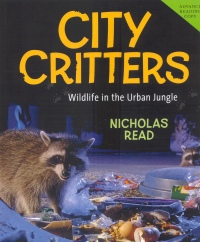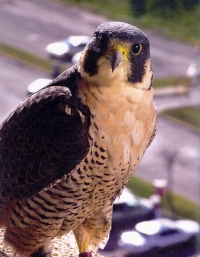| ________________
CM . . .
. Volume XVIII Number 25. . . .March 2, 2012 
 |
City Critters: Wildlife in the Urban Jungle.
Nicholas Read.
Victoria, BC: Orca, 2012.
144 pp., pbk., $19.95.
ISBN 978-1-55469-394-8.
Subject Heading:
Urban animals-Juvenile literature.
Grades 5-9 / Ages 10-14.
Review by Gillian Richardson.
***1/2 /4
Reviewed from Advance Reading Copy.
|
| |
|

excerpt:
And is there a city in the United States or Canada that isn't overrun with squirrels? Not likely. Most city squirrels are eastern gray squirrels, so named because they originated on the eastern side of North America. But now they live all over the west too. Squirrels do well in cities. In addition to nuts and seeds, which they eat in the wild, cities are full of bird feeders. And for squirrels a bird feeder is like an all-you-can-eat brunch at your favorite restaurant. Even though urban predators such as coyotes, foxes, owls and hawks hunt squirrels, there aren't enough predators to make a real dent in squirrel numbers. In other words, don't expect the squirrels scampering up the tree outside your window to disappear anytime soon.
We often see 'human interest' stories in the media about the adventures (or misadventures) of an animal in a city. We might shake our heads, wondering how on earth the creature found itself in such a setting. But more and more, those animals that might once have been strangers to an urban environment are actually at home there. City Critters offers a detailed discussion of how and why so many wild animals have found city living to their liking, and how our actions encourage them to share our urban world.
 Author Nicholas Read introduces readers to the range of critters first, everything from spiders in the basement to alligators in your back yard pool…depending on where you live. While small mammals, birds and insects may have always found homes around our buildings and gardens, it is only more recently that larger animals, such as coyotes, deer, eagles and bears, have turned up regularly. Read points out the reasons: easy access to food, dwindling habitat in the wild, security from large predators, climate change that makes cities comfortable, sheltered places. In seven more chapters, Read describes the urban lifestyles of mammals, marine mammals, fish, birds, birds that swim (the chapter title is "Birds Who Swim"…but isn't 'who' reserved for humans?), reptiles and amphibians, insects and spiders. His inclusive coverage is impressive. In the conclusion, "What We Can do for Them," he discusses how we help animals inadvertently by leaving food around, and knowingly by using native plantings to attract them, avoiding use of pesticides and by accepting their presence for the most part. A Glossary, Resources (organizations dedicated to animals), and an Index will complete the book. The list of experts consulted across Canada and the US attests to the level of research undertaken. Author Nicholas Read introduces readers to the range of critters first, everything from spiders in the basement to alligators in your back yard pool…depending on where you live. While small mammals, birds and insects may have always found homes around our buildings and gardens, it is only more recently that larger animals, such as coyotes, deer, eagles and bears, have turned up regularly. Read points out the reasons: easy access to food, dwindling habitat in the wild, security from large predators, climate change that makes cities comfortable, sheltered places. In seven more chapters, Read describes the urban lifestyles of mammals, marine mammals, fish, birds, birds that swim (the chapter title is "Birds Who Swim"…but isn't 'who' reserved for humans?), reptiles and amphibians, insects and spiders. His inclusive coverage is impressive. In the conclusion, "What We Can do for Them," he discusses how we help animals inadvertently by leaving food around, and knowingly by using native plantings to attract them, avoiding use of pesticides and by accepting their presence for the most part. A Glossary, Resources (organizations dedicated to animals), and an Index will complete the book. The list of experts consulted across Canada and the US attests to the level of research undertaken.
City Critters is not a book to skim through as the conversational writing style is meticulous and rich with fascinating anecdotes about various human/wildlife encounters. Read's wry sense of humor infuses many of the tales, but the serious nature of the topic is never underestimated. In each chapter, the author points out how urbanization has created this situation: "As cities get bigger and more sprawling, wilderness areas get smaller and more limited…" The other focus is on the adaptability of the animals: "In the wild, coyotes are both predator and prey…..In the city, they don't [have to worry about] what's chasing them." An interesting portion of the book deals with marine mammals, fish and other aquatic animals which we don't naturally think of as 'urban' critters. But, as the author points out, many cities are built next to busy waterways, meaning whales, manatees or sea lions often show up close to shore, and sea stars, hermit crabs and clams make their homes in tidal zone where we often see them at low tide. Birds are more familiar to city folk, but in this population, too, we are seeing species which used to prefer wild areas: falcons, owls, eagles, cormorants. In the case of peregrine falcons nesting on tall buildings, the author might have pointed out the role biologists played in establishing this urban nesting habit with experimental breeding programs several decades ago to help the falcons recover from the ravages of DDT and habitat loss. Read's information is generally right up to date, though, as in the example of the imported Burmese pythons that have made the news recently as dangerous invaders and a threat to native species and humans alike in Florida.
Read sums up the book with a phrase he used at the beginning: "...it's a hard time to be a wild animal." With news almost daily about another species being listed as endangered or worse, the information here will go a long way to informing readers of the ways animals are hanging on, and even thriving in our midst. If you haven't taken notice of them up to now, or realized how extensive their presence has become, City Critters will help you know where to find them, watch them, learn about them and marvel at their resolve. It's clear from the information here that 'wild animals among us' is the new reality.
Photos are used generously throughout the book, and they are mainly good quality and appropriately placed. Many are small but well captioned. A few are rather dark and lack clarity: a goose (pg 80), someone feeding swans (pg 81) and spider web (pg 113). The book was reviewed from an advance copy, so perhaps alternatives are planned.
City Critters will add significantly to the bank of knowledge on this topic by filling a spot that appears to be occupied by only shorter, less comprehensive titles aimed at a younger audience.
Highly Recommended.
Gillian Richardson is a freelance writer living in BC.

To comment
on this title or this review, send mail to cm@umanitoba.ca.
Copyright © the Manitoba Library Association. Reproduction for personal
use is permitted only if this copyright notice is maintained. Any
other reproduction is prohibited without permission.
NEXT REVIEW |
TABLE OF CONTENTS FOR THIS ISSUE
- March 2, 2012.
AUTHORS |
TITLES |
MEDIA REVIEWS |
PROFILES |
BACK ISSUES |
SEARCH |
CMARCHIVE |
HOME |

 Author Nicholas Read introduces readers to the range of critters first, everything from spiders in the basement to alligators in your back yard pool…depending on where you live. While small mammals, birds and insects may have always found homes around our buildings and gardens, it is only more recently that larger animals, such as coyotes, deer, eagles and bears, have turned up regularly. Read points out the reasons: easy access to food, dwindling habitat in the wild, security from large predators, climate change that makes cities comfortable, sheltered places. In seven more chapters, Read describes the urban lifestyles of mammals, marine mammals, fish, birds, birds that swim (the chapter title is "Birds Who Swim"…but isn't 'who' reserved for humans?), reptiles and amphibians, insects and spiders. His inclusive coverage is impressive. In the conclusion, "What We Can do for Them," he discusses how we help animals inadvertently by leaving food around, and knowingly by using native plantings to attract them, avoiding use of pesticides and by accepting their presence for the most part. A Glossary, Resources (organizations dedicated to animals), and an Index will complete the book. The list of experts consulted across Canada and the US attests to the level of research undertaken.
Author Nicholas Read introduces readers to the range of critters first, everything from spiders in the basement to alligators in your back yard pool…depending on where you live. While small mammals, birds and insects may have always found homes around our buildings and gardens, it is only more recently that larger animals, such as coyotes, deer, eagles and bears, have turned up regularly. Read points out the reasons: easy access to food, dwindling habitat in the wild, security from large predators, climate change that makes cities comfortable, sheltered places. In seven more chapters, Read describes the urban lifestyles of mammals, marine mammals, fish, birds, birds that swim (the chapter title is "Birds Who Swim"…but isn't 'who' reserved for humans?), reptiles and amphibians, insects and spiders. His inclusive coverage is impressive. In the conclusion, "What We Can do for Them," he discusses how we help animals inadvertently by leaving food around, and knowingly by using native plantings to attract them, avoiding use of pesticides and by accepting their presence for the most part. A Glossary, Resources (organizations dedicated to animals), and an Index will complete the book. The list of experts consulted across Canada and the US attests to the level of research undertaken.